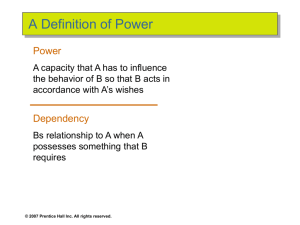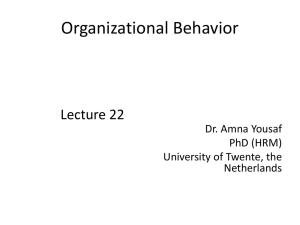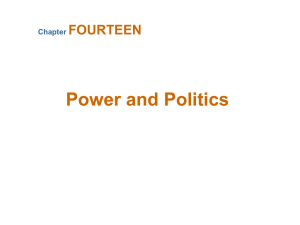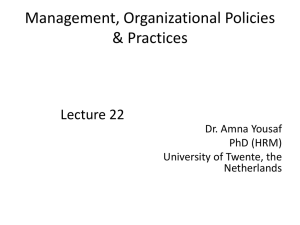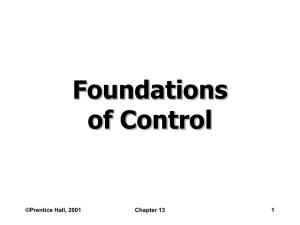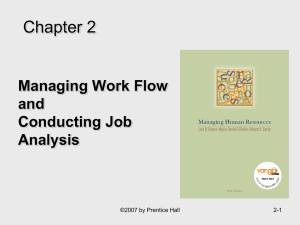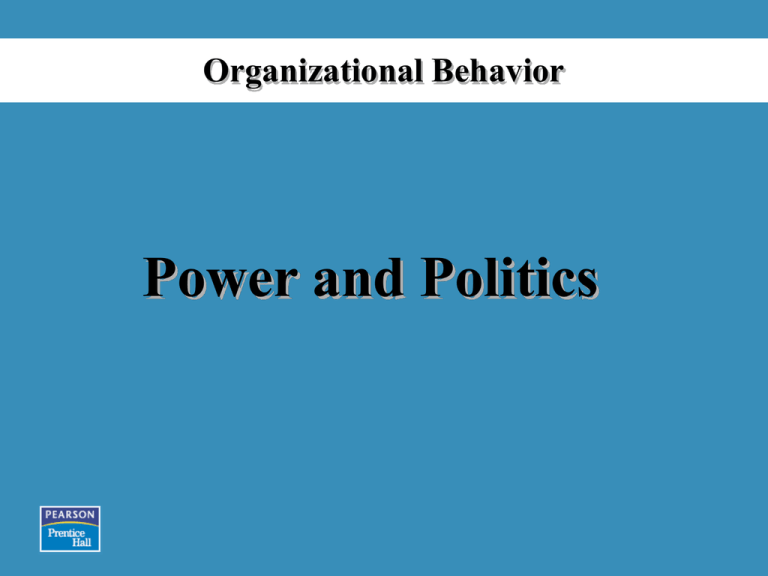
Organizational Behavior
Power and Politics
A Definition of Power
Power
Kapasitas yang dimiliki seseorang (A) untuk
mempengaruhi perilaku orang lain (B), sehingga
B mau berbuat seperti yang diinginkan oleh A.
Dependency
Keterikatan seseorang (B) kepada
orang lain (A), karena A menguasai/
memiliki sesuatu yang diinginkan
oleh B.
© 2005 Prentice Hall Inc. All rights reserved.
A
B
Contrasting Leadership and Power
Leadership
– Focuses on goal
achievement.
– Requires goal
compatibility with
followers.
– Focuses influence
downward.
© 2005 Prentice Hall Inc. All rights reserved.
Power
– Used as a means for
achieving goals.
– Requires follower
dependency.
– Used to gain lateral
and upward
influence.
Bases of Power: Formal Power
Formal Power
Is established by an individual’s position in an
organization; conveys the ability to coerce or
reward, from formal authority, or from control of
information.
Coercive Power
A power base dependent on fear.
Reward Power
Compliance achieved based on the
ability to distribute rewards that others
view as valuable
© 2005 Prentice Hall Inc. All rights reserved.
Bases of Power: Formal Power (cont’d)
Legitimate Power
The power a person receives as a result of his
or her position in the formal hierarchy of an
organization.
Information Power
Power that comes from access
to and control over
information.
© 2005 Prentice Hall Inc. All rights reserved.
Bases of Power: Personal Power
Expert Power
Influence based on special
skills or knowledge.
Referent Power
Influence based on possession
by an individual of desirable
resources or personal traits.
Charismatic Power
An extension of referent power stemming from an
individual’s personality and interpersonal style.
© 2005 Prentice Hall Inc. All rights reserved.
Dependency: The Key To Power
The General Dependency Postulate
– The greater B’s dependency on A, the greater the
power A has over B.
– Possession/control of scarce organizational resources
that others need makes a manager powerful.
– Access to optional resources (e.g., multiple suppliers)
reduces the resource holder’s power.
What Creates Dependency
– Importance of the resource to the organization
– Scarcity of the resource
– Non-substitutability of the resource
© 2005 Prentice Hall Inc. All rights reserved.
Power Tactics
Power Tactics
Ways in which
individuals translate
power bases into
specific actions.
Influence Tactics:
• Legitimacy
• Rational persuasion
• Inspirational appeals
• Consultation
• Exchange
• Personal appeals
• Ingratiation
• Pressure
• Coalitions
© 2005 Prentice Hall Inc. All rights reserved.
Preferred Power Tactics by Influence Direction
Upward Influence Downward Influence
Lateral Influence
Rational persuasion
Rational persuasion
Rational persuasion
Inspirational appeals
Consultation
Pressure
Ingratiation
Consultation
Exchange
Ingratiation
Legitimacy
Exchange
Personal appeals
Legitimacy
Coalitions
© 2005 Prentice Hall Inc. All rights reserved.
Factors Influencing the Choice and
Effectiveness of Power Tactics
Sequencing of tactics
– Softer to harder tactics
works best.
Skillful use of a tactic
– Experienced users are
more successful.
Relative power of the tactic
user
– Some tactics work better
when applied downward.
The type of request
attaching to the tactic
– Is the request legitimate?
© 2005 Prentice Hall Inc. All rights reserved.
How the request is
perceived
– Is the request accepted
as ethical?
The culture of the
organization
– Culture affects user’s
choice of tactic
Country-specific cultural
factors
– Local values favor certain
tactics over others.
Power in Groups: Coalitions
Coalitions
Clusters of individuals
who temporarily come
together to a achieve a
specific purpose.
• Seek to maximize their
size to attain influence.
• Seek a broad and diverse
constituency for support
of their objectives.
• Occur more frequently in
organizations with high
task and resource
interdependencies.
• Occur more frequently if
tasks are standardized
and routine.
© 2005 Prentice Hall Inc. All rights reserved.
Sexual Harassment: Unequal Power in the
Workplace
Sexual Harassment
– Unwelcome advances, requests for sexual favors, and
other verbal or physical conduct of a sexual nature.
The U.S. Supreme Court test for determining if
sexual harassment has occurred:
– whether comments or behavior
in a work environment
“would reasonably be
perceived, and is
perceived, as hostile
or abusive.”
© 2005 Prentice Hall Inc. All rights reserved.
Politics: Power in Action
Political Behavior
Activities that are not required as part of one’s
formal role in the organization, but that influence, or
attempt to influence, the distribution of advantages
or disadvantages within the organization.
Legitimate Political Behavior
Normal everyday politics.
Illegitimate Political Behavior
Extreme political behavior that violates the implied
rules of the game.
© 2005 Prentice Hall Inc. All rights reserved.
Politics Is in the Eye of the Beholder
“Political” Label
“Effective Management” Label
1. Blaming others
vs.
Fixing responsibility
2. “Kissing up”
vs.
Developing working relationships
3. Apple polishing
vs.
Demonstrating loyalty
4. Passing the buck
vs.
Delegating authority
5. Covering your rear
vs.
Documenting decisions
6. Creating conflict
vs.
Encouraging change and innovation
7. Forming coalitions
vs.
Facilitating teamwork
8. Whistle blowing
vs.
Improving efficiency
9. Scheming
vs.
Planning ahead
10. Overachieving
vs.
Competent and capable
11. Ambitious
vs.
Career-minded
12. Opportunistic
vs.
Astute
13. Cunning
vs.
Practical-minded
14. Arrogant
vs.
Confident
15. Perfectionist
vs.
Attentive to detail
© 2005 Prentice Hall Inc. All rights reserved.
Factors That Influence
Political Behaviors
© 2005 Prentice Hall Inc. All rights reserved.
Employee Responses to
Organizational Politics
© 2005 Prentice Hall Inc. All rights reserved.
Avoiding Action:
Defensive
Behaviors
• Over conforming
• Buck passing
• Playing dumb
Avoiding Blame:
• Stretching
• Buffing
• Stalling
• Playing safe
• Justifying
• Scapegoating
• Misrepresenting
Avoiding Change:
• Prevention
• Self-protection
© 2005 Prentice Hall Inc. All rights reserved.
Impression Management (IM)
Impression Management
The process by which
individuals attempt to
control the impression
others form of them.
IM Techniques:
• Conformity
• Excuses
• Apologies
• Self-Promotion
• Flattery
Source: Based on B. R. Schlenker, Impression Management (Monterey, CA:
Brooks/Cole, 1980); W. L. Gardner and M. J. Martinko, “Impression
Management in Organizations,” Journal of Management, June 1988, p. 332;
and R. B. Cialdini, “Indirect Tactics of Image Management Beyond Basking,”
in R. A. Giacalone and P. Rosenfeld (eds.), Impression Management in the
Organization (Hillsdale, NJ: Lawrence Erlbaum Associates, 1989), pp. 45–71.
© 2005 Prentice Hall Inc. All rights reserved.
• Favors
• Association
Is A Political Action Ethical?
Utilitarianism
Rights
Source: Adapted from G.F. Cavanagh, D. Moberg, and M. Valasquez,
“The Ethics of Organizational Politic,” Academy of Management Review,
July 1981, p. 368. Reprinted with permission.
© 2005 Prentice Hall Inc. All rights reserved.
Justice
Topik minggu depan ……..
Conflict and Negotiation
ORGANIZATIONAL BEHAVIOR
S T E P H E N P. R O B B I N S
E L E V E N T H
E D I T I O N
WWW.PRENHALL.COM/ROBBINS
© 2005 Prentice Hall Inc. All rights reserved.

